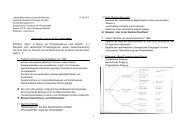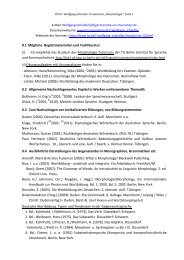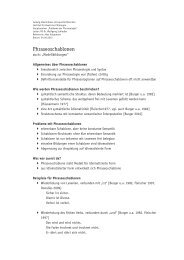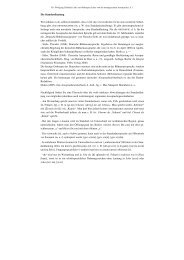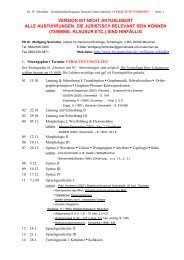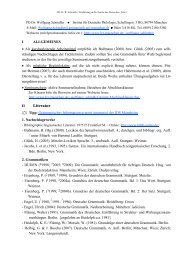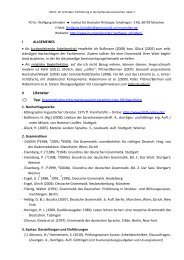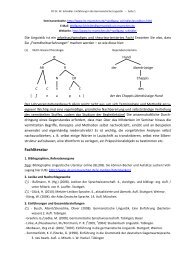Chapter 18 Lexical Functions: Description of Lexical Relations in a ...
Chapter 18 Lexical Functions: Description of Lexical Relations in a ...
Chapter 18 Lexical Functions: Description of Lexical Relations in a ...
You also want an ePaper? Increase the reach of your titles
YUMPU automatically turns print PDFs into web optimized ePapers that Google loves.
—<strong>Chapter</strong> <strong>18</strong>. <strong>Lexical</strong> <strong>Functions</strong>— 73<br />
7) Indications on morphological peculiarities <strong>of</strong> L´ (special forms, miss<strong>in</strong>g forms—e.g., “| no<br />
plural”, or “| no passive”, ...).<br />
8) Indications on stylistic properties <strong>of</strong> L´ (<strong>in</strong>formal, slang, literary, ...).<br />
To sum up: In the general case, if the LU L´ appear<strong>in</strong>g as an element <strong>of</strong> the value <strong>of</strong> an LF<br />
differs from the free LU L´ <strong>in</strong> its GP or <strong>in</strong> some other details, it does not necessarily have a full-<br />
fledged entry <strong>of</strong> its own but may be described by a subentry with<strong>in</strong> the entry <strong>of</strong> its keyword L.<br />
(L´ receives its own entry only if it appears with exactly the same properties <strong>in</strong> several lexical<br />
entries as an element <strong>of</strong> the value <strong>of</strong> the same LF.)<br />
5.2. Generaliz<strong>in</strong>g over the Values <strong>of</strong> <strong>Lexical</strong> <strong>Functions</strong><br />
In spite <strong>of</strong> the basically idiosyncratic character <strong>of</strong> LFs, <strong>in</strong> many cases a given LF f may<br />
have the same values for quite a few different keywords: you take a BATH, a SHOWER, and a<br />
REST; you are <strong>in</strong> DESPAIR, LOVE, and a RAGE; you follow the RULES, PRESCRIPTIONS, RECOM-<br />
MENDATIONS, and INSTRUCTIONS. As is clear, the reason is ma<strong>in</strong>ly semantic proximity: seman-<br />
tically related LUs tend to feature the same values for a given LF. This fact can be accounted for<br />
by the Pr<strong>in</strong>ciple <strong>of</strong> lexical <strong>in</strong>heritance (Mel’čuk & Wanner 1996):<br />
Pr<strong>in</strong>ciple <strong>of</strong> <strong>Lexical</strong> Inheritance<br />
All lexicographic data systematically shared by a family <strong>of</strong> semantically related LUs should<br />
be stored just once—under one LU <strong>of</strong> the correspond<strong>in</strong>g vocable or under the generic LU<br />
<strong>of</strong> the correspond<strong>in</strong>g semantic field; these data are <strong>in</strong>herited by the LUs <strong>in</strong>volved.<br />
In the doma<strong>in</strong> <strong>of</strong> LFs, this pr<strong>in</strong>ciple applies <strong>in</strong> two major ways. Namely, the elements <strong>of</strong> the<br />
values <strong>of</strong> the LF f shared by several keyword LUs can be generalized by extract<strong>in</strong>g them from <strong>in</strong>-<br />
dividual keyword entries and stor<strong>in</strong>g them together just once—either on the keyword side (for a<br />
group <strong>of</strong> LUs) or on the LF side (attach<strong>in</strong>g them to the LF). Of course, <strong>in</strong> practice both ways can<br />
be comb<strong>in</strong>ed <strong>in</strong> different proportions. Each <strong>of</strong> these approaches to LF value generalization has, <strong>in</strong><br />
turn, two further versions, so that we have, all <strong>in</strong> all, four techniques for <strong>Lexical</strong> Inheritance. To<br />
wit, the shared LF values can be grouped:<br />
Generaliz<strong>in</strong>g on the keyword side<br />
1. under a convenient LU (this can be the basic lexeme <strong>of</strong> the same vocable or a lexeme <strong>of</strong> a<br />
different vocable); or<br />
2. under the generic LU <strong>of</strong> the correspond<strong>in</strong>g semantic field.<br />
Generaliz<strong>in</strong>g on the LF side<br />
3. under the LF itself; or


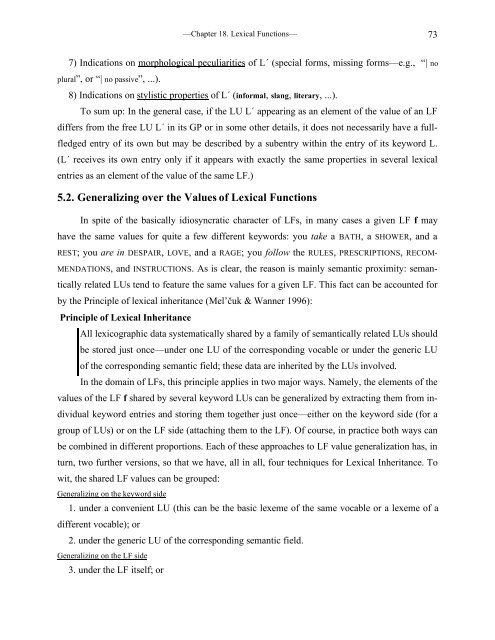
![E-Mail: Wolfgang.Schindler[ätt]germanistik.uni-muenchen.de Web ...](https://img.yumpu.com/51590147/1/184x260/e-mail-wolfgangschindlerattgermanistikuni-muenchende-web-.jpg?quality=85)
